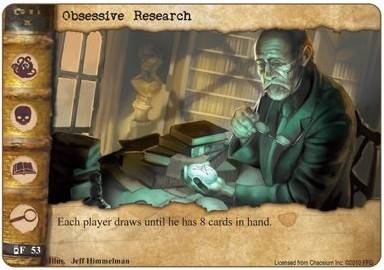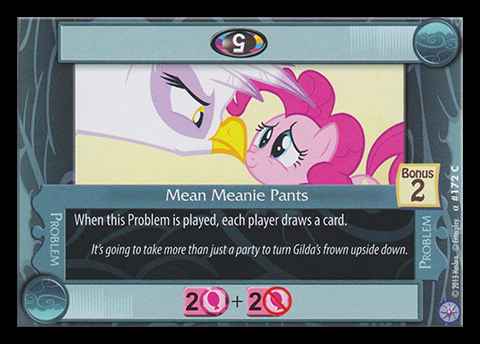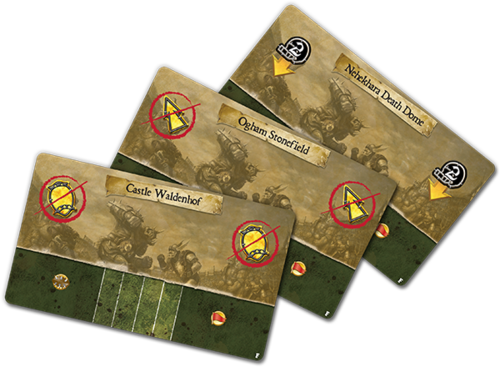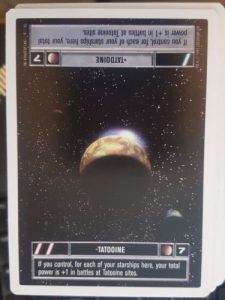
One of the hallmarks of western card game design since the early 90s with Decipher Inc, is the “location” or “mission” card. You can see its presence even today in some of Fantasy Flight’s biggest earners. I’m here to say that I don’t think this style of game design really works for dueling card games. Their apparent primary narrative purpose is to give a sense of dimension to the board—making it somewhat like a board game, and add a layer of depth to the game. Its apparent mechanical purpose is to split player resources across various goals (locations/missions tend to give rewards). This is a style of prescriptive design wherein the designer assigns a mechanic to the game and players must play around this mechanic. This is opposed to a freestyle game such as Magic the Gathering and Yu-Gi-Oh or a semi-prescriptive game such as Pokemon. In those games, you can pretty much do what you want within a much larger constraint space. Players tend to value that large space because it acts like a sandbox that gives them authority and power to craft their own style of play and consequently, their own player-driven narrative. But maybe mission cards are just kinda bad.

For gaming, there may be no “right” answer regarding narrative source. Sometimes, player-driven narratives are engaging and incredibly fun. I think anyone who has played Minecraft can agree that when left to explore the games boundaries on our own, we players do a great job of entertaining ourselves. There’s also something to be said for prescriptive narratives—the idea that a competent storyteller can make something even more compelling and suck you into their world. However, from a game design perspective, prescriptive rules tend to suck to design for after they’re made.
When I create a rule in a game, I have to know how it will interact with every single piece of that game. I have two choices: the rule can be part of a framework that the game is built around or it can be embedded in the play itself. An example would be making a rule to limit players to playing only 1 of an Orange colored card per turn, or you can print all your Orange cards that need the rule with “Play only if you played no other Orange cards this turn”. The first one seems attractive because it’s DRY (Don’t Repeat Yourself), but the second one is more flexible in that some Orange cards could be played as the second Orange card that turn, bypassing the restriction and opening up play space. In addition, the hard-coded version takes up a designer’s design space, limiting it greatly. I can’t make any Orange colored cards that are weaker in potency but allowed to be played at more than once per turn with the Orange rule hard-coded.
Sometimes, limiting design space is fine or even necessary. In Pokemon, the ACE-Spec cards were clearly far more powerful versions of existing cards and had every right to be limited to 1 “ACE-Spec” per deck. I do the same with “ACE” cards in Digimon Battle Evolution, and a similar thing with “FIREWALL” cards. Other times, it’s maybe not needed. With a mission-style card game, you’re not working toward the free-form goal of reducing your opponent’s life to zero or getting six prize cards through battle, you’re performing various goals (usually at random) that completely shape the method of winning the game. See the problem? The goals are ill-defined for the players. Even in games like My Little Pony or Star Wars where you get to bring your own missions, locations, problems or whatever snazzy word is used to describe the same goal-resolution scheme, you’re still unsure what your opponent can bring. That often leads to designing decks in fog of insecurity. Even worse is when all of the missions are known such as with Call of Cthulhu. In that game, players can only build decks that are good at achieving the basics in the game, since you will always try to win one or more of a terror, combat, lore, and investigation phase. Once you win or are unchallenged enough, you get a randomly selected prize via that card. Sure, players know what they get before they score it, but they don’t know the order of the missions before their opening hand is drawn, therefore they cannot plan individual moves for future goals. This means a “draw 8 cards” reward is incredibly lame if your hand is full because you played conservatively, whereas “take 2 cards from your discard pile” would be great because the cards you did play were of high quality and you’d like to reuse them.

When you have expansions (like Call of Cthulhu or Blood Bowl Team Manager) for missions, you end up with an even weirder circumstance where players must agree on the deck beforehand. Obviously, this isn’t a problem most of the time for the target audience of these games. There’s a reason none of these types of games have ever become mainstream, hardcore dueling games with a high level of competition. There’s nothing wrong with being a niche game for a significantly lower target audience, after all. However, it must be said that a large component of why the games cannot and will not have mass appeal is due to the prescriptive nature (yet erratic) of the game’s goals.

Let’s get back to one of its purposes: to split player resources. Often times, these sorts of games will have some kind of resource (cards, magic, dice, whatever) that are gained through careful play or planning during the game. These cards inevitably split up that pool of resources to spread players thin. The idea is that players can focus in one of two extreme ways: spread thin or go all-in. To quote the Star Wars decipher game’s reasoning “The more you tighten your grip, the more star systems will slip through your fingers”, as an obvious nod to Leia’s quote to Tarkin. Magic players aren’t new to the split between going “wide” and going “tall”, but Magic is far more free-form and allows rapid pivoting, as long as you planned for it. Outside of a free-form game, splitting your resources just means doing less. Doing more (by not splitting) just means giving up more. It’s not a very interesting choice and is usually just a microcosm of some of the choices available in sandbox games.
In addition, in Star Wars, and many games like it, you’re not changing these goals much once they hit the board. This immutability is another problem with prescriptive goal games. In a life-points based game, your goal is just to make someone reach 0 (from 20, 30, 8000, whatever) and you have a lot of freedom and many options to achieve that goal. In these prescriptive goal games, how you achieve that goal might change somehow during the game, but rarely reverts back or pivots. Players just sort of have to deal with it and move on.
I’m not sure that we’ll ever see this style of gameplay become popular with players in my lifetime. I think there are design elements regarding it that are too fundamentally unsavory for the masses to find it appealing on a large scale. The force of a strong IP (Star Wars) and a strong publisher (Fantasy Flight) can come together at the most economically opportune time (now) and still not breach the popularity threshold of most open card games. They should exist, if only because it will fill the niche for players that find this gameplay fun. But designers may want to re-think how often they include this mechanic when it’s clearly not as popular as they hope.
Do you have a favorite card game with mission, location, goal, or problem cards of some kind?
Does it replace your favorite sandbox card game?
How do you find the forced splitting of your resources? Does it feel choking, tactical or something else?
Lend me your thoughts, dear reader.

Leave a comment